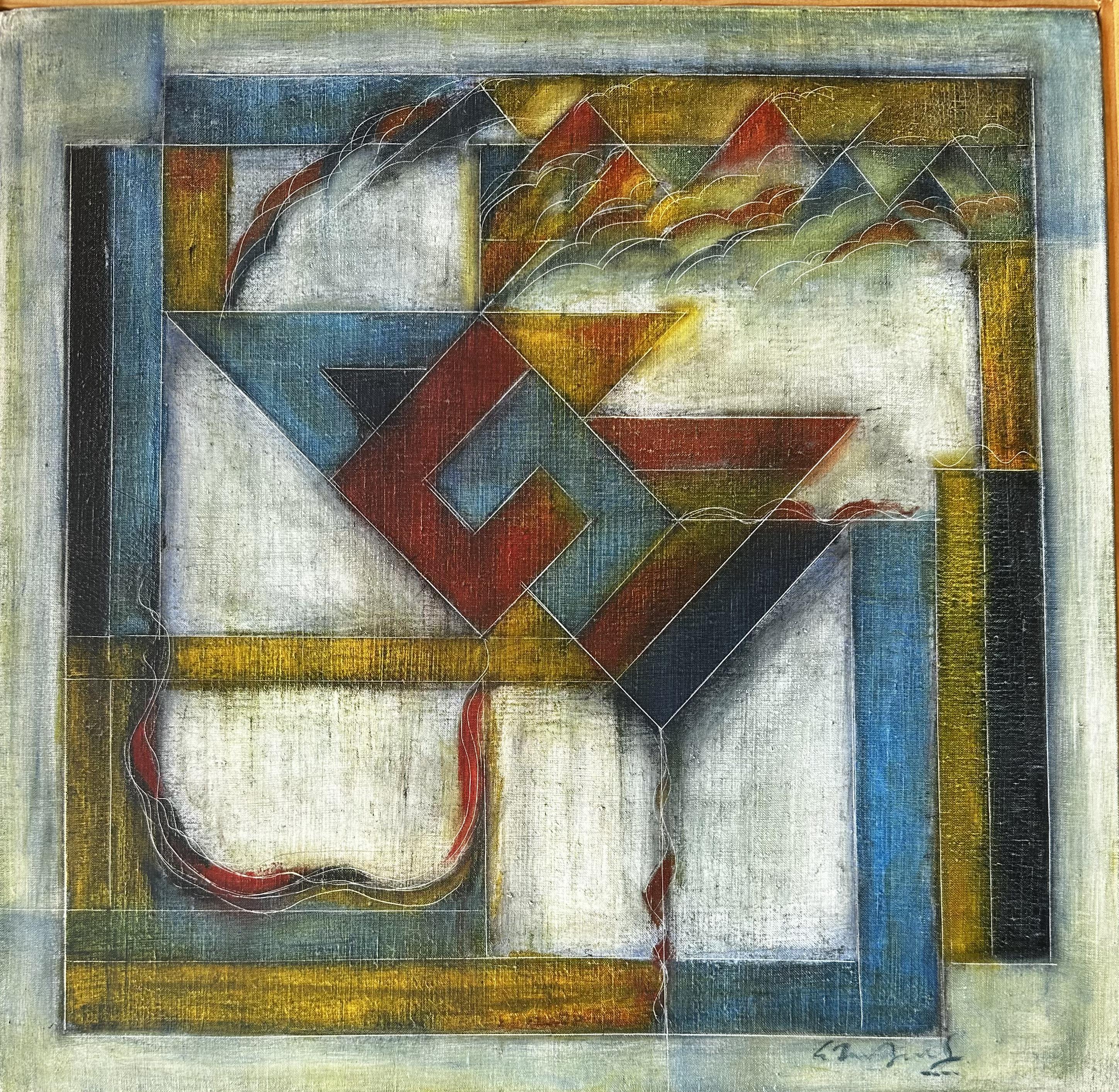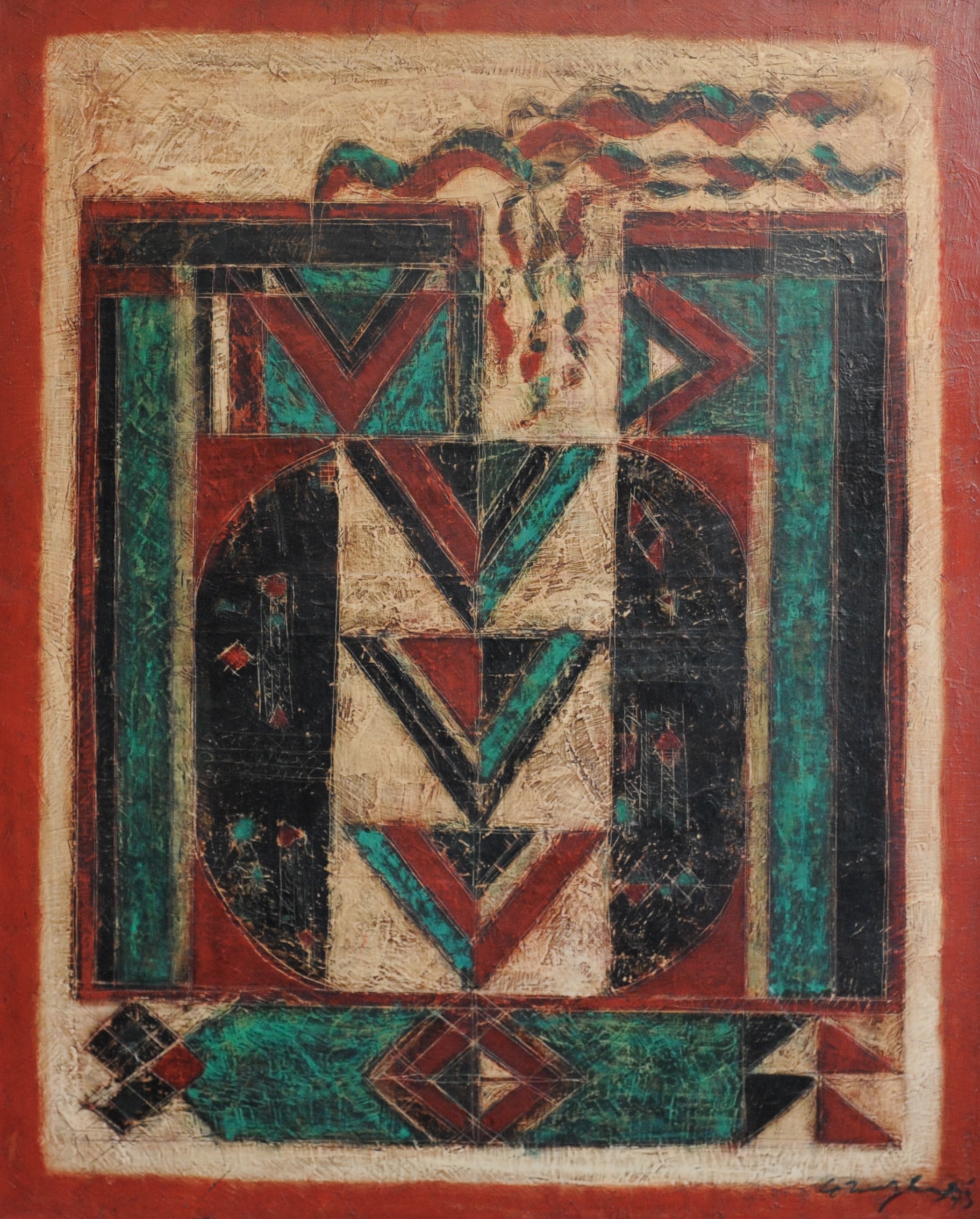A six-decade retrospective of Akkitham Narayanan’s work
A landmark show offers a broad exploration of Akkitham Narayanan’s evocative body of work — an invitation into his visual cosmology, where geometry, spirituality and memory converge. On view at the Jehangir Art Gallery in Mumbai until November 25, the show, ‘Geometries of the Infinite’, has been curated by Anahita Daruwala Banerjee and presented by Artworld.
Born in Kerala in 1939, Narayanan is one of the most remarkable voices in Indian abstract painting. His art is often described as a fusion of Indian tantric symbolism and European geometric abstraction — a delicate balancing act between the spiritual and the rational. What sets his practice apart is his nuanced relationship with form, colour and the invisible. Though formally abstract, his compositions often gesture toward elemental motifs — triangles, circles, serpentine curves — as if these archetypal shapes carry latent spiritual meaning.
As this retrospective of his works opens in Mumbai (Artworld earlier took his works to Chennai), we ask him how he evaluates his journey so far. “When I look back, I see it as quite a normal progression, but the moments that truly stand out are the exhibitions. Each exhibition has brought a sense of enthusiasm and excitement that has made the journey feel special.”
 Artwork by Akkitham Narayanan.
Artwork by Akkitham Narayanan.
His works transform geometry into a meditative language. He says it simply evolves on its own. “I do what feels natural, and if people find something meditative in it, that is entirely up to them. I like that aspect — that the work takes its own form and meaning without any forced intention.”
Throughout his career, the artist has experimented with texture, relief and layered surfaces. He says he chooses what helps bring the image in his mind to life. “There is nothing particularly calculated or special about the selection; it is simply about using what supports the idea I want to express.”
During the initial years of his journey as an artist, he was mentored by KCS Paniker. Narayanan says the mentorship he received from Paniker is something he carried forward in his work. However, after him, he preferred pushing himself, “finding my own direction rather than depending on anyone else for guidance”.
 Artwork by Akkitham Narayanan.
Artwork by Akkitham Narayanan.
After obtaining a Diploma in Painting from the Government School of Arts & Crafts, Chennai, he proceeded to Paris on a scholarship to study at the École des Beaux-Arts, where he honed his mastery in monumental art and engraving under Jean Bertholle and Lucien Couteau. Over the decades, he settled in Paris while continuing to engage deeply with Indian visual traditions and philosophical thought.
We ask him if India is a better place to practise art today than it was five decades ago. “India has progressed tremendously over the last 50 years. Today, there are modern materials, modern imagery and new forms of expression. The environment for art and artists has expanded and evolved significantly compared to the time when I moved to Paris,” he says.
Curator Anahita Daruwala says that the starting point behind the show was never to treat the retrospective as a chronological archive but as a living conversation that has unfolded across six decades. “Akkitham Sir’s practice has a remarkable coherence, his questions deepen, his language refines, but the spiritual enquiry at the heart of it remains steady. My role was to make that continuity visible without reducing the work to a timeline.”
She says she approached the show almost like mapping a constellational field. “Instead of moving decade by decade, I allowed visual and philosophical links to speak to each other, circles painted forty years apart, shifts in colour that reveal changing states of contemplation, the quiet expansion of his geometry into something more meditative. This helped the exhibition feel contemporary. At the same time, I was conscious that today’s visitors engage differently with pace, with expectation, with emotional bandwidth. So, the structure of the exhibition invites slowness. There are intentional pauses, breathing spaces and shifts in scale that allow viewers to encounter the works afresh. The idea was to let the legacy remain intact but present it in a way that resonates with a contemporary sensibility — one hungry for stillness, clarity and meaning.”
 Artwork by Akkitham Narayanan.
Artwork by Akkitham Narayanan.
In today’s art ecosystem, where figurative and conceptual art often dominate, how does she position abstract and contemplative practices like Narayanan’s within broader conversations of Indian modernism and spirituality? “I think what often gets forgotten in today’s conversations is that Indian modernism was never purely formal or stylistic; it emerged from a deep philosophical lineage. Artists like Akkitham Sir remind us that abstraction in India was inseparable from a spiritual inquiry. His geometry is not an academic exercise; it is a meditative discipline rooted in temple structures, sacred proportion and a lifelong dialogue with the infinite.”
Hence, when she positions his practice today, she frames it not as an alternative to figurative or conceptual art but as part of a parallel lineage that continues to be profoundly relevant. “We live in a moment of overwhelming complexity, constant noise and intellectualisation. His work offers the opposite: clarity, stillness, a return to essence. That, I believe, resonates powerfully with contemporary audiences who are increasingly seeking depth rather than distraction. Abstract and contemplative practices like his open a different kind of conversation, one that bridges modernism with metaphysics, form with devotion, and discipline with inner quiet. And that is a conversation India needs to reclaim,” she concludes.
On at Jehangir Art Gallery, Kala Ghoda, Mumbai, until November 25
Features